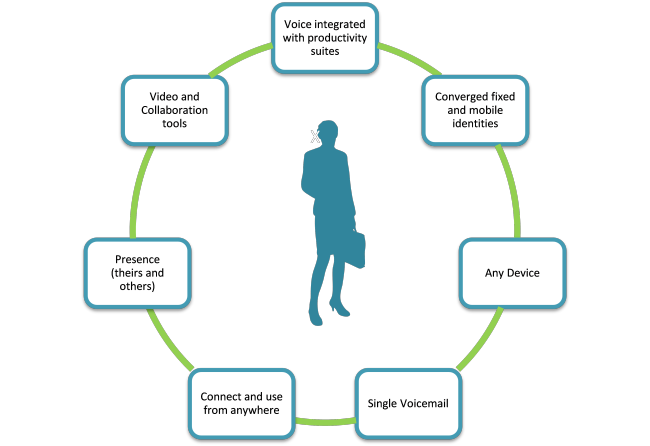Telco 2.0™ Research
The Future Of Telecoms And How To Get There
The Future Of Telecoms And How To Get There
|
Summary: Disruption is taking place across the voice and messaging space - not just with telcos. Established vendors and de facto technology standards are also being challenged. For example, Cisco, the market leader in enterprise telephony, finds itself being disrupted in key markets by other vendors offering more horizontally integrated solutions. This report provides an overview and insight into a number of vendors and technologies in the voice and messaging markets, including telco platforms and services, and LTE, RCSe, and WebRTC. Three telco case studies (Vodafone, Telefonica and AT&T) are also provided, examining their activities, products and results. (February 2014, Executive Briefing Service, Dealing with Disruption Stream.) |
|
Below is an extract from this 43 page Telco 2.0 Report that can be downloaded in full in PDF format by members of the Telco 2.0 Executive Briefing service and the Dealing with Disruption Stream here. Non-members can subscribe here or other enquiries, please email / call +44 (0) 207 247 5003.
We will also be covering disruption and transformation in depth at our Silicon Valley (Palo Alto, May 20-21) and EMEA (London, June 10-11) Brainstorms.
To share this article easily, please click:
This is an edited extract of two sections from the latest Telco 2.0 Strategy Report, The Future Value of Voice and Messaging, for members of the premium Telco 2.0 Executive Briefing Service.
The full report:
There are many vendors and products in the voice/telephony arena. Some started as pure voice products or solutions like Cisco Call Manager, while others such as Microsoft Office 365 started as an office productivity suite, to which voice and presence became a natural extension, and then later a central part of the core product functionality. We have included details on RCS, however RCS is not globally available, and is limited in its functionality compared to some of the other products listed here.
Unified Communications (UC) is not a standard; there are many different interpretations, but there is a general consensus about what it means – the unification of voice, video, messaging, presence, conferencing, and collaboration into a simple integrated user experience.
UC is an important technology for enterprise customers, it brings mobility and agility to an organisation, improves communication and collaboration, adds a social element, and lowers costs by reducing the need for office space and multiple disparate communications systems each with their own management and control systems. UC can be delivered as a cloud service and has the acronym UCaaS. Leading providers are Microsoft, Google, and Cisco. Other players include IBM, 8X8, and a number of other smaller vendors, as well as telco equipment manufacturers such as Ericsson. We have covered some of the leading solutions in this report, and there are definite opportunities for telcos to collaborate with these vendors, adding integration with core services such as telephony and mobile data, as well as customer support and billing.
There are several elements for an enterprise to consider when developing a UC solution for it to be successful:
From the user perspective, it would be desirable for the solution to include the basic elements shown in Figure 1.

Source: STL Partners
Historically, Enterprise communications has been an area where telcos have been a supplier to the enterprise – delivering voice end points (E.164 phone numbers and mobile devices), voice termination, and outgoing voice and data services.
Organisational voice communications (i.e. internal calling) has been an area of strength for companies like Cisco, Avaya, Nortel and others that have delivered on-premise solutions which offer sophisticated voice and video services. These have grown over the years to provide Instant Messaging (IM), desktop collaboration tools, and presence capabilities. PC clients often replace fixed phones, adding functionality, and can be used when out of the office. What these systems have lacked is deep integration with desktop office suites such as Microsoft Office, Google Apps, and Lotus Notes. Plug-ins or other tools can be used to integrate presence and voice, but the user experience is usually a compromise as different vendors are involved.
The big software vendors have also been active, with Microsoft and IBM adding video and telephony features, and Google building telephony and conferencing into its growing portfolio. Microsoft also acquired Skype and has delivered on its promise to integrate Skype with Lync. Meanwhile, Google has made a number of acquisitions in the video and voice arena like ON2, Global IP Solutions, and Grand Central. The technology from ON2 allows video to be compressed and sent over an Internet connection. Google is pushing the products from ON2 to be integrated into one of the next major disruptors – WebRTC.
Microsoft began including voice capability with its release of Office Communications Server (OCS) in 2007. An OCS user could send instant messages, make a voice call, or place a video call to another OCS user or group of users. Presence was directly integrated with Outlook and a separate product – Office Live Meeting - was used to collaborate. Although OCS included some Private Branch eXchange (PBX) features, few enterprises regarded it as having enough features or capability to replace existing systems from the likes of Cisco. With Office 365, Microsoft stepped up the game, adding a new user interface, enhanced telephony features, integrated collaboration, and multiple methods of deployment using Microsoft’s cloud, on premise, and service provider deployments.
To read the note in full, including the following analysis...
...and the following figures...
...Members of the Telco 2.0 Executive Briefing Subscription Service and the Dealing with Disruption Stream can download the full 43 page report in PDF format here. Non-Members, please subscribe here or other enquiries, please email / call +44 (0) 207 247 5003.
Technologies and industry terms referenced: Cisco, Microsoft, Lync, Google, Skype, WebRTC, Voxeo, Twilio, Tropo, Hypervoice, Calltrunk, Telecoms, Voice, Messaging, Unified Communications, Strategy, AT&T, Telefonica, Vodafone, Tu Me, Tu Go, BlueVia, Free Wi-Fi, LTE, RCSe.